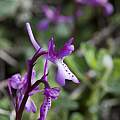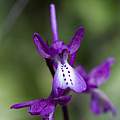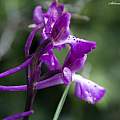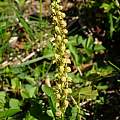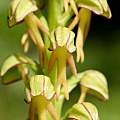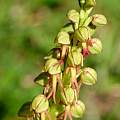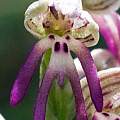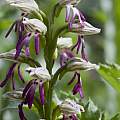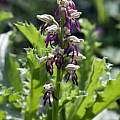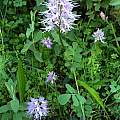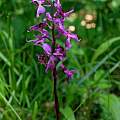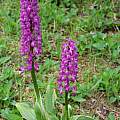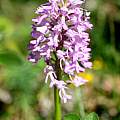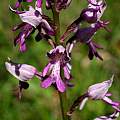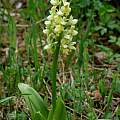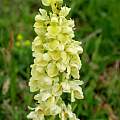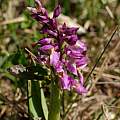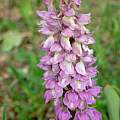Orchis (L.) is the name giving Genus of the Orchidaceae family. The name, which was first mentioned by Theophrastus around 300 B.C., originates from the two tubers which remind of testicles. This special configuration is caused by the lifecycle of the plant: While the current year's tuber withers, next year's tuber is formed in parallel. Flowers of Orchis are arranged in a more or less strict spike, the colors are mostly pink or purple, with few yellow, red or greenish species. With one exception (O. anthropophora), there is no winter leaf rosette present as in several related genera. Both morphology and genetics suggest a split in two subgenera: subgenus Orchis with closed helmets and split lips, and subgenus Masculeae with wide lips and a more open helmet.
Center of diversity is the Mediterranean, but some species reach north to the Norwegian coast, south to Morocco and Israel and east to lake Baikal. The genus is closely related to Anacamptis and Neotinea?, with several species moved in between those in a revision of the genus in 1997. Other related genera include Dactylorhiza, Gymnadenia, Habenaria, Ophrys and Platanthera.
Orchis anatolica Boiss is accepted, and its native range is Aegean Islands to Israel and W. Iran. At flowering time it has two ovoid tubers. The flower spike up to 15 cm tall has 2 to 15 very loosely arranged flowers. This species prefers the semi-shade of bright pine woods but also grows in shrubs. It needs alkaline soil. Source: Plants of the World Online
Shlomit Heymann photographed these blooming early March in Israel where it is a protected species according to Wild Flowers of Israel.
Orchis anthropophora (L)All is a wintergreen species of the subgenus Orchis. At times it had been moved to its own monotypic genus Aceras, but its hybridization with several species of subgenus Orchis proved that wrong. The name literally means "man carrying orchid", which is quite fitting given the shape of the lip. As the flowers open up, the lip is vividly red, but fades quickly to a pale greenish brown. The species prefers slightly shaded south facing dry grassland slopes in western Europe and the western Mediterranean, but also reaches up to the southeast of England. Height: 20-40 cm. Pictures by Martin Bohnet from the Swabian Jura, which is near the north eastern border of the range.
Orchis galilaea (Bornm. & M.Schulze) Schltr. is accepted, and its native range is S. Turkey to Israel. Height: to about 25 cm. Shlomit Heymann photographed these blooming early March in Israel where it is protected and blooms February through April according to Wild Flowers of Israel.
Orchis italica Poir. is a mid-sized Orchis which spreads along the coastal areas of the Mediterranean all the way from Israel to Spain, and even along the Atlantic in Portugal and Morocco, and rises inland up to an altitude of about 1300 m (4200 ft), flowering in local mid spring, which can be early March to mid May depending on altitude.
Specimens of Orchis italica can be easily recognized by the wavy leaves, a feature unique in the genus. Spots on the leaves are optional. Inflorescences stay dense and compact, and the flower's lips are man-shaped, as it is typical for subgenus Orchis. Photo by Johannes-Ulrich Urban in habitat in the Algarve.
Orchis mascula L. is a big, conspicious Orchis spreading throughout western Europe, from Portugal to Norway, but can also be found on the Balkans, Turkey and parts of Georgia and Armenia. It prefers open forests on lime soil. Flowers are dark pink to purple, often with a spotted lip and slightly facing downwards, opposing an upwards-pointing spur of about the length of the ovary. Leaves may be spotted, but this feature varies widely. Photos by Martin Bohnet taken in habitat on the Swabian Jura, southern Germany.
Orchis militaris L. is the type species of the genus. It is has the widest distribution of all species, spreading from most of Europe to Lake Baikal. It mostly grows in calcareous grassland on south-facing slopes in colder areas, reaching into wetter grounds as average temperature rises. Its habitat is threatened by eutrophication and intensification of agriculture, but where the conditions fit, it can be locally abundant.
The up to 40 cumarin-scented flowers of Orchis militaris are pale pink with a bright pink to purple rim and spots on the large, split lip. A minor spur is present. The epithet "militaris" is a reference to the helmet-shaped remaining petals. The leaves are plain green and forming a ground rosette, with usually two additional leaves protecting the stem. Photos by Martin Bohnet in habitat in the Swabian Alp.
Orchis militaris is sometimes offered commercially.
Orchis pallens L. is one of the few yellow-flowered terrestrial Orchids of Europe, flowering mid- to late spring as one of the first orchids in the northern part of its area, which spreads from northern Spain throughout the Alps, German Mittelgebirge, northern Italy and the Balkans to parts of the Turkish north coast. It prefers open forests or not too dry meadows on shell lime. The pale yellow flowers with an unspotted, somewhat darker lip contain no nectar. Photos by Martin Bohnet of plants growing on the Swabian Jura, southern Germany.
Hybrids
Natural hybrids in Orchis tend to exist wherever two species overlap locally and in flowering time. Sometimes, whole hybrid swarms with intermediate traits occur. Artificial hybrids are less common, mostly because Orchis is not (yet?) often used in gardening.
Orchis x loreziana Brügger (Syn. Orchis x hausnechtii) is a natural hybrid of Orchis mascula and Orchis pallens, not uncommon where both species overlap. In stature and early flowering habit these plants are often quite close to the all yellow Orchis pallens, while the pink color is inherited from Orchis mascula. Still, the yellow throat of the flowers is the best trait to identify the hybrid. Photos by Martin Bohnet taken in habitat on the Swabian Jura, southern Germany.
